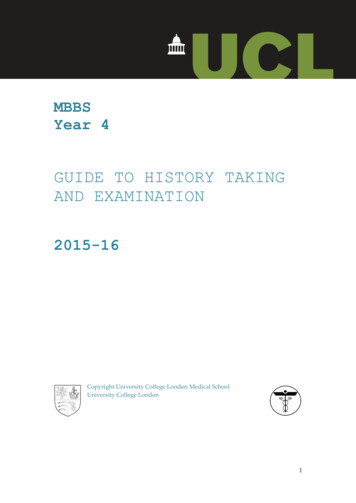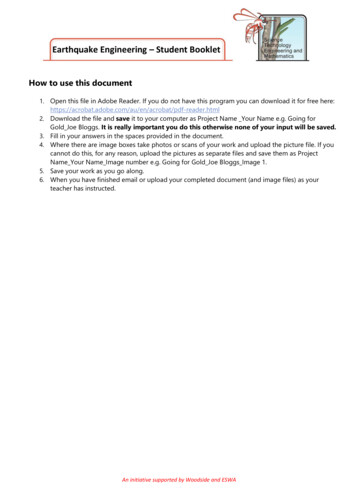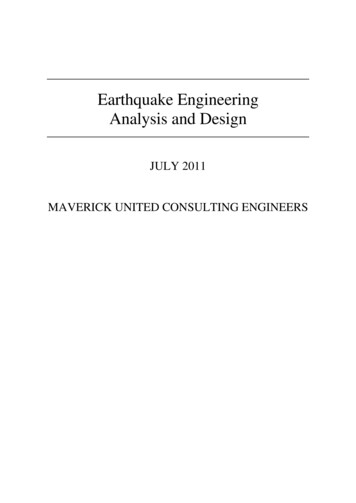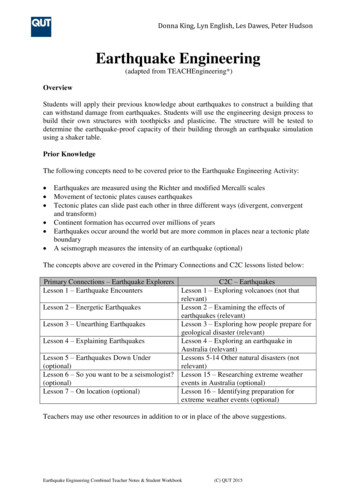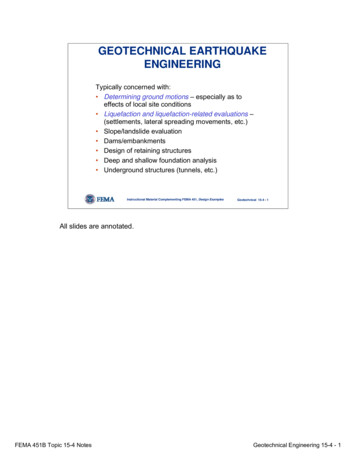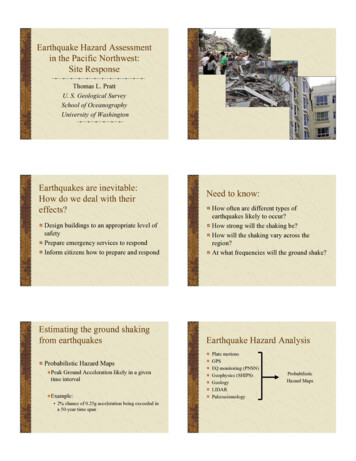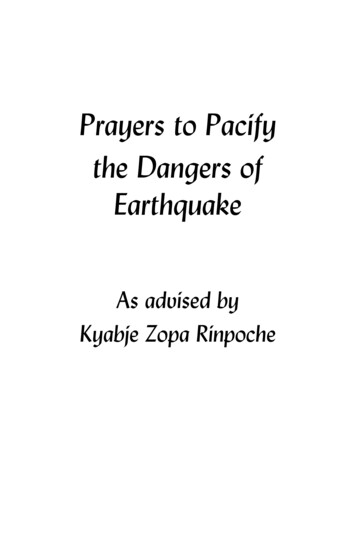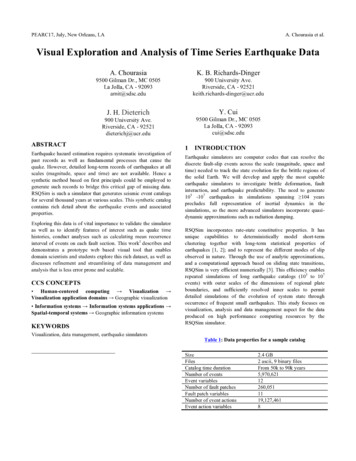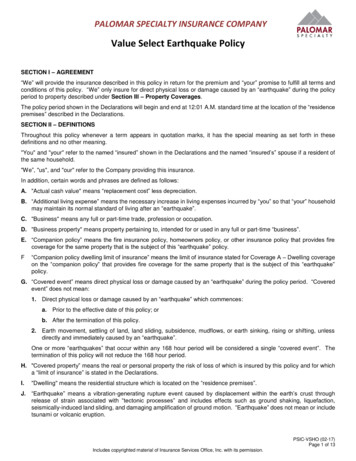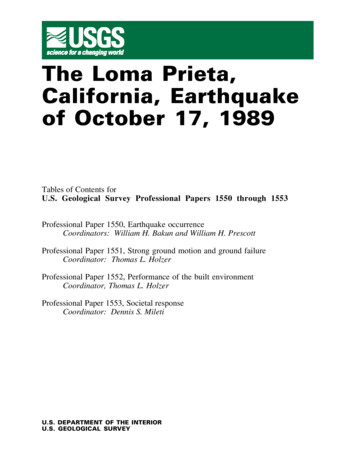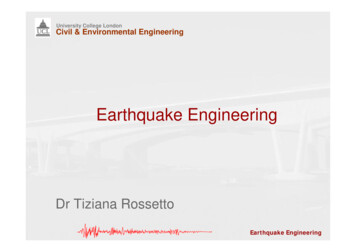
Transcription
University College LondonCivil & Environmental EngineeringEarthquake EngineeringDr Tiziana RossettoEarthquake Engineering
University College LondonCivil & Environmental EngineeringIntroduction In the past 3 centuries over 3 million people have dieddue to earthquakes and earthquake related disasters. The economic losses estimated for the period 1929-1950are in excess of US 10 billion. 2/3 of the earths crust is seismically active, which meansthat about 1,000,000,000 people are living in areas ofthe world that are prone to earthquakes.Earthquake Engineering
University College LondonCivil & Environmental EngineeringIntroductionFor more developed countries the economic loss due toan earthquake can be enormous even if the death toll isfairly low (Coburn and Spence 1992):e.g. Kobe Earthquake (Ms 7.0, Japan, 1995) killed5,420 people but caused US 150 billion economic lossEarthquake Engineering
University College LondonCivil & Environmental Engineeringcost ofdamage perfatalityEarthquake Engineering
University College LondonCivil & Environmental EngineeringIntroductionFor more developed countries the economic loss due toan earthquake can be enormous even if the death toll isfairly low (Coburn and Spence 1992):e.g. Kobe Earthquake (Ms 7.0, Japan, 1995) killed5,420 people but caused US 150 billion economic lossBut cost is relative:e.g. Managua earthquake (Ms 6.1, Nicaragua, 1972),caused 10,000 deaths and US 2 billion economic loss. .but This loss 40% of GNPEarthquake Engineering
University College LondonCivil & Environmental EngineeringIntroductionWhat do we know? Earthquakes cannot be prevented nor accuratelypredicted. It is not ground shaking itself that causes life andeconomic loss but the collapse or damage of buildingsand infrastructure that are too “weak” to resist the groundshaking.Earthquake Engineering
University College LondonCivil & Environmental EngineeringWhat is Earthquake Engineering?The application of civil engineering toreduce life and economic losses due toearthquakes,(i.e to mitigate seismic risk)Earthquake Engineering
University College LondonCivil & Environmental EngineeringWhat is Seismic Risk from theengineers’ perspective?the probability of losses occurring due toearthquakes within the lifetime of astructure; these losses can includehuman lives, social and economicdisruption as well as material damage.Earthquake Engineering
University College LondonCivil & Environmental EngineeringWhat is Seismic Risk?RISK SEISMIC HAZARD x VULNERABILITYEarthquake Engineering
University College LondonCivil & Environmental EngineeringWhat is Seismic Risk?RISK SEISMIC HAZARD x VULNERABILITYProbability of a potentially damagingearthquake effect occurring at the site ofplanned construction within its design life.Earthquake Engineering
University College LondonCivil & Environmental EngineeringWhat earthquake effects cause damage? Ground shakingBhuj E/q, India 2001Loma Prieta, CA 1989Earthquake Engineering
University College LondonCivil & Environmental EngineeringWhat earthquake effects cause damage? Ground shakingEarthquake Engineering
University College LondonCivil & Environmental EngineeringWhat earthquake effects cause damage? Ground shaking Surface ruptureChi Chi E/q, TaiwanHector Mines E/q, USAEarthquake Engineering
University College LondonCivil & Environmental EngineeringWhat earthquake effects cause damage? Ground shaking Surface rupture LandslidesEarthquake Engineering
University College LondonCivil & Environmental EngineeringWhat earthquake effects cause damage? Ground shaking Surface rupture Landslides LiquefactionEarthquake Engineering
University College LondonCivil & Environmental EngineeringWhat earthquake effects causedamage? Ground shaking Surface rupture Landslides LiquefactionEarthquake Engineering
University College LondonCivil & Environmental EngineeringWhat earthquake effects cause damage? Ground shaking Surface rupture Landslides Liquefaction TsunamisEarthquake Engineering
University College LondonCivil & Environmental EngineeringWhat is Seismic Risk?is the probability of the occurrence ofdamage in a building when exposed to aparticular earthquake effect.RISK SEISMIC HAZARD x VULNERABILITYProbability of a potentially damagingearthquake effect occurring at the site ofplanned construction within its design life.Earthquake Engineering
University College LondonCivil & Environmental EngineeringWhat is Seismic Risk?DETERMINED BY MAN: CAN BEREDUCED THROUGH SEISMICDESIGNRISK SEISMIC HAZARD x VULNERABILITYDETERMINED BY NATURE:CANNOT BE REDUCEDEarthquake Engineering
University College LondonCivil & Environmental EngineeringSeismic Hazard and Seismic DesignDesign Problem: An earthquake usually constitutes themost severe loading to which most civil engineeringstructures might possibly be subjected, and yet in mostparts of the world, even those that are highly seismic, thereis a possibility that an earthquake may not occur during thelife of the structure.Note: Lateral loads imposed by winds 1-3% of building weight.Lateral loads due to earthquakes 25-30% of building weight.Earthquake Engineering
University College LondonCivil & Environmental EngineeringSeismic Hazard and Seismic DesignDesign Problem: An earthquake usually constitutes themost severe loading to which most civil engineeringstructures might possibly be subjected, and yet in mostparts of the world, even those that are highly seismic, thereis a possibility that an earthquake may not occur during thelife of the structure.Assessment Problem: Most buildings that exist have notbeen designed to seismic codes. Can they withstand thetype of earthquake that might happen in their location?What will be the damage incurred if an earthquake doesoccur?Earthquake Engineering
University College LondonCivil & Environmental EngineeringSeismic Hazard and Seismic DesignHence, engineers require seismic hazardassessments to provide not only a description ofthe likely seismic loads (ground shaking) to beexperienced by an engineering structure, but alsoto attach probabilities of occurrence to theseearthquake loads.Earthquake Engineering
University College LondonCivil & Environmental EngineeringHow do earthquake measurementstranslate into earthquake design loads? Seismograms can be used directly as input to complicateddynamic inelastic time history finite element analyses ofimportant buildings.Earthquake Engineering
University College LondonCivil & Environmental EngineeringHow do earthquake measurementstranslate into earthquake design loads? Seismograms can be used directly as input to complicateddynamic inelastic time history finite element analyses ofimportant buildings.Earthquake Engineering
University College LondonCivil & Environmental EngineeringHow do earthquake measurementstranslate into earthquake design loads? Seismograms used directly as input to complicateddynamic inelastic time history finite element analyses ofimportant buildings. Earthquake Acceleration Spectra and Peak GroundAcceleration. Spectral modal analysis methods Equivalent lateral force methodsEarthquake Engineering
University College LondonCivil & Environmental EngineeringComputation of Elastic ResponseSpectrumPlot maximumresponse accelerationvs fundamental periodof SDOFSingle degreeof freedomsystemsEarthquake Engineering
University College LondonCivil & Environmental EngineeringElastic and Inelastic SpectraEarthquake Engineering
University College LondonCivil & Environmental EngineeringDesign Spectra (EC8) 2.5.agShape will be differentfor different soilconditions. i.e. siteamplification effects areconsideredEarthquake Engineering
University College LondonCivil & Environmental EngineeringCode-type zonation mapEarthquake Engineering
University College LondonCivil & Environmental EngineeringT1T2T3T2 T1Earthquake Engineering
University College LondonCivil & Environmental EngineeringEquivalent Lateral LoadV C.W ( F m.a)Sa (T1 )C . I . S .qg I Importance factorSa(T1) spectral accelerationfor fundamental period, includessite effects q behaviour factor, representsstructure’s ability to dissipate energyVEarthquake Engineering
University College LondonCivil & Environmental EngineeringConventional Seismic DesignNormal building life assumed to 50yearsUltimate limit state design: Design a building to resist anearthquake with a return period of 475yrs (i.e. the designloads will have a 10% probability of being exceeded in thestructures life).If a structure is very important (i.e. the consequences of itsdamage are severe) these loads will be increased: e.g.Nuclear structures designed to resist a 10,000 year returnperiod event.Earthquake Engineering
University College LondonCivil & Environmental EngineeringConventional Seismic DesignNormal building life assumed to 50yearsUltimate limit state design: Design a building to resist anearthquake with a return period of 475yrs (i.e. the designloads will have a 10% probability of being exceeded in thestructures life).If we design for the seismic loads to be resisted bythe building without damage (i.e. for the building toreact elastically) the cost of construction would beprohibitiveSo we design buildings to be damaged underearthquake loadingEarthquake Engineering
University College LondonCivil & Environmental EngineeringDesigning for Controlled DamageWe design buildings to be damaged and react inelastically:meaning they dissipate the same energy, but will undergogreater deformation during the eventForce (P)PeEqual EnergyRulePiDisplacement (δ)δyδeδuEarthquake Engineering
University College LondonCivil & Environmental EngineeringDesigning for Controlled DamageWe design buildings to be damaged and react inelastically:meaning they dissipate the same energy, but will undergogreater deformation during the eventThe location of the damaged areas is controlled to avoidcatastrophic failure.Simple design rules andcapacity designEarthquake Engineering
University College LondonCivil & Environmental EngineeringSimple Design Criteria Choose an adequate lateral load resisting systemEarthquake Engineering
University College LondonCivil & Environmental EngineeringAdequate Lateral Load Resisting SystemsMoment resistingframe: RC up to 5 floorsConcentricallybraced frame Steel up to 2 floors“fuse”Eccentricallybraced framesEarthquake Engineering
University College LondonCivil & Environmental EngineeringSimple Design Criteria Choose an adequate lateral load resisting system Maintain regularity in plan and elevation (of stiffness andmass distribution)Earthquake Engineering
University College LondonCivil & Environmental EngineeringRegularity in PlanEarthquake Engineering
University College LondonCivil & Environmental EngineeringRegularity in ElevationEarthquake Engineering
University College LondonCivil & Environmental EngineeringRegularity in ElevationEarthquake Engineering
University College LondonCivil & Environmental EngineeringRegularity in hquake Engineering
University College LondonCivil & Environmental Engineering“Soft-storey” FailureEarthquake Engineering
University College LondonCivil & Environmental Engineering“Soft-storey” FailureEarthquake Engineering
University College LondonCivil & Environmental Engineering“Soft-storey” FailureEarthquake Engineering
University College LondonCivil & Environmental EngineeringSimple Design Criteria Choose an adequate lateral load resisting system Maintain regularity in plan and elevation (of stiffness andmass distribution) Ensure connection between structural elements Connecting and anchoring of reinforcement Using appropriate materialsEarthquake Engineering
University College LondonCivil & Environmental EngineeringPoor ConnectionEarthquake Engineering
University College LondonCivil & Environmental EngineeringPremature shear failure throughinappropriate detailingFukae Viaduct, Kobe 1995Earthquake Engineering
University College LondonCivil & Environmental EngineeringPremature shear failure throughinappropriate detailingFukae Viaduct, Kobe 1995Earthquake Engineering
University College LondonCivil & Environmental EngineeringEarthquake Engineering
University College LondonCivil & Environmental EngineeringEarthquake Engineering
University College LondonCivil & Environmental EngineeringPoor ConnectionEarthquake Engineering
University College LondonCivil & Environmental EngineeringSimple Design Criteria Choose an adequate lateral load resisting system Maintain regularity in plan and elevation (of stiffness andmass distribution) Ensure connection between structural elements Avoid designing in locations of stress concentrationEarthquake Engineering
University College LondonCivil & Environmental EngineeringLocal Stress PointsShortcolumnEarthquake Engineering
University College LondonCivil & Environmental EngineeringShort Column FailureShortcolumnEarthquake Engineering
University College LondonCivil & Environmental EngineeringSimple Design Criteria Choose an adequate lateral load resisting system Maintain regularity in plan and elevation (of stiffness andmass distribution) Ensure connection between structural elements Avoid designing in locations of stress concentration Consider dynamic response in determining spacingbetween buildings, so as to avoid poundingEarthquake Engineering
University College LondonCivil & Environmental EngineeringPoundingEarthquake Engineering
University College LondonCivil & Environmental EngineeringPoundingEarthquake Engineering
University College LondonCivil & Environmental EngineeringSimple Design Criteria Choose an adequate lateral load resisting system Maintain regularity in plan and elevation (of stiffness andmass distribution) Ensure connection between structur
Earthquake Engineering Civil & Environmental Engineering University College London Simple Design Criteria Choose an adequate lateral load resisting system Maintain regularity in plan and elevation (of stiffness and mass distribution) Ensure connection between structural elements Avoid designing in locations of stress concentration Consider dynamic response in determining .
